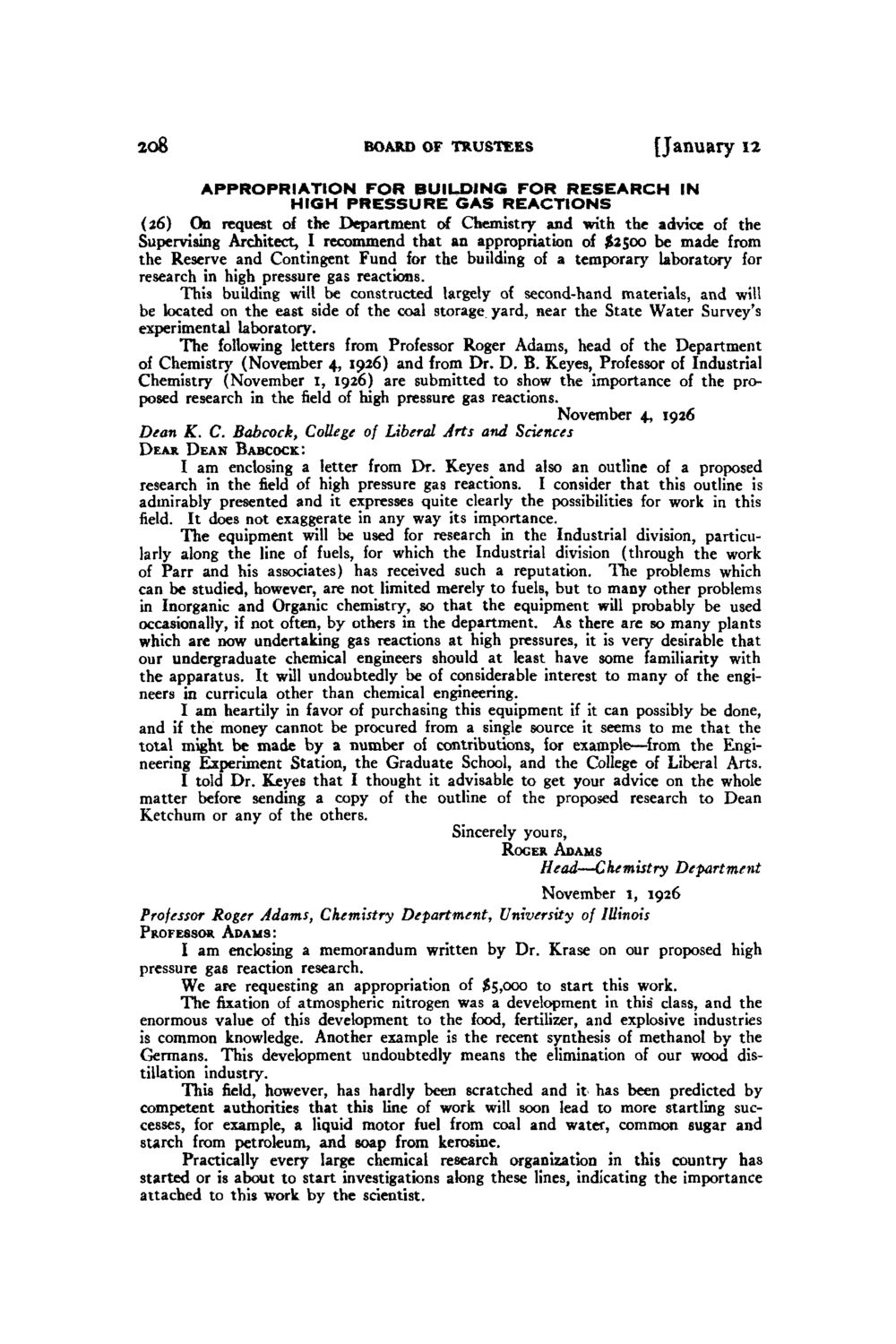| |
| |
Caption: Board of Trustees Minutes - 1928
This is a reduced-resolution page image for fast online browsing.

EXTRACTED TEXT FROM PAGE:
208 board of trustees [January 12 A P P R O P R I A T I O N F O R B U I L D I N G F O R R E S E A R C H IN HIGH P R E S S U R E G A S REACTIONS (26) On request of the Department of Chemistry and with the advice of the Supervising Architect, I recommend that an appropriation of $2500 be made from the Reserve and Contingent Fund for the building of a temporary laboratory for research in high pressure gas reactions. This building will be constructed largely of second-hand materials, and will be located on the east side of the coal storage yard, near the State Water Survey's experimental laboratory. The following letters from Professor Roger Adams, head of the Department of Chemistry (November 4, 1926) and from Dr. D. B. Keyes, Professor of Industrial Chemistry (November I, 1926) are submitted to show the importance of the proposed research in the field of high pressure gas reactions. November 4, 1926 Dean K. C. Babcock, College of Liberal Arts and Sciences Dear Dean Babcock: I am enclosing a letter from Dr. Keyes and also an outline of a proposed research in thefieldof high pressure gas reactions. I consider that this outline is admirably presented and it expresses quite clearly the possibilities for work in this field. It does not exaggerate in any way its importance. The equipment will be used for research in the Industrial division, particularly along the line of fuels, for which the Industrial division (through the work of Parr and his associates) has received such a reputation. The problems which can be studied, however, are not limited merely to fueU, but to many other problems in Inorganic and Organic chemistry, so that the equipment will probably be used occasionally, if not often, by others in the department. As there are so many plants which are now undertaking gas reactions at high pressures, it is very desirable that our undergraduate chemical engineers should at least have some familiarity with the apparatus. It will undoubtedly be of considerable interest to many of the engineers in curricula other than chemical engineering. I am heartily in favor of purchasing this equipment if it can possibly be done, and if the money cannot be procured from a single source it seems to me that the total might be made by a number of contributions, for example—from the Engineering Experiment Station, the Graduate School, and the College of Liberal Arts. I told Dr. Keyes that I thought it advisable to get your advice on the whole matter before sending a copy of the outline of the proposed research to Dean Ketchum or any of the others. Sincerely yours, Roger Adams Head—Chemistry Department November 1, 1926 Professor Roger Adams, Chemistry Department, University of Illinois Professor Adams: I am enclosing a memorandum written by Dr. Krase on our proposed high pressure gas reaction research. W e are requesting an appropriation of $5,000 to start this work. Thefixationof atmospheric nitrogen was a development in this" class, and the enormous value of this development to the food, fertilizer, and explosive industries is common knowledge. Another example is the recent synthesis of methanol by the Germans. This development undoubtedly means the elimination of our wood distillation industry. Thisfield,however, has hardly been scratched and it has been predicted by competent authorities that this line of work will soon lead to more startling successes, for example, a liquid motor fuel from coal and water, common sugar and starch from petroleum, and soap from kerosine. attached to about to start investigations along these lines, indicating country has started or isthis work by the scientist. research organization in this the importance Practically every large chemical
| |